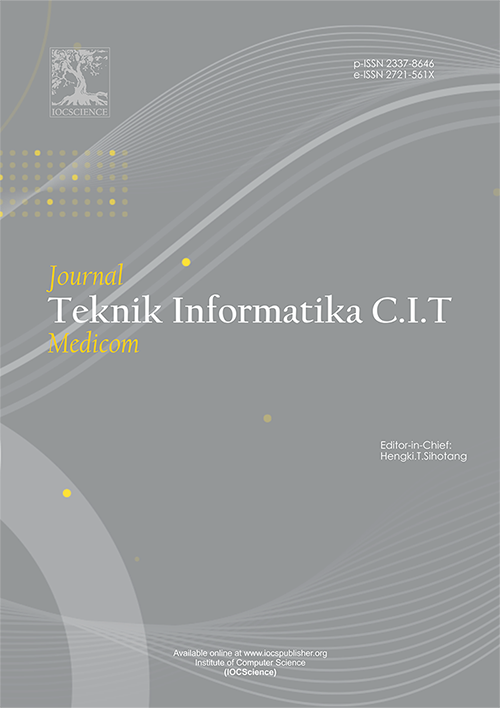Evaluation of ARIMA model performance in projecting future sales: case study on electronic products
DOI:
https://doi.org/10.35335/cit.Vol16.2024.993.pp329-337Keywords:
ARIMA, Sales prediction, Electronic products, Model accuracy, External factor analysisAbstract
The sales performance of electronic products is significantly affected by a variety of internal and external factors, necessitating precise forecasting models to aid strategic decision-making. This research investigates the effectiveness of ARIMA models in predicting future sales, focusing on a case study involving electronic products. The study utilizes monthly sales data obtained from company records and industry databases. The methodology includes assessing data stationarity through the Augmented Dickey-Fuller (ADF) test, applying differencing when required, and determining ARIMA parameters using Autocorrelation Function (ACF) and Partial Autocorrelation Function (PACF) analyses. The findings reveal that ARIMA models effectively capture seasonal variations and trend patterns. Their performance is assessed using metrics such as Mean Absolute Percentage Error (MAPE), Root Mean Square Error (RMSE), and Mean Absolute Error (MAE). This study highlights the need to incorporate external factors into prediction models to enhance accuracy and recommends exploring alternative approaches that can better adapt to dynamic market conditions.
Downloads
References
Y. Li, Y. Tan, Y. Pu, Y. Zhu, and H. Xie, “Exploring the drivers of green supply chain management in the Chinese electronics industry: Evidence from a GDEMATEL–AISM approach,” Clean. Logist. Supply Chain, vol. 7, p. 100110, 2023, doi: https://doi.org/10.1016/j.clscn.2023.100110.
L. Tao, R. Tao, and N. Xie, “Optimization of the seru production system with demand fluctuation: A Mean-CVaR model,” Comput. Ind. Eng., vol. 199, p. 110760, 2025, doi: https://doi.org/10.1016/j.cie.2024.110760.
Y. Zhang, G. Berenguer, and Z.-H. Zhang, “A subsidized reverse supply chain in the Chinese electronics industry,” Omega, vol. 122, p. 102937, 2024, doi: https://doi.org/10.1016/j.omega.2023.102937.
S. Chen, S. Ke, S. Han, S. Gupta, and U. Sivarajah, “Which product description phrases affect sales forecasting? An explainable AI framework by integrating WaveNet neural network models with multiple regression,” Decis. Support Syst., vol. 176, p. 114065, 2024, doi: https://doi.org/10.1016/j.dss.2023.114065.
R. Tosepu and N. Y. Ningsi, “Forecasting of diarrhea disease using ARIMA model in Kendari City, Southeast Sulawesi Province, Indonesia,” Heliyon, vol. 10, no. 22, p. e40247, 2024, doi: https://doi.org/10.1016/j.heliyon.2024.e40247.
F. Tolesh and S. Biloshchytska, “Forecasting international migration in Kazakhstan using ARIMA models,” Procedia Comput. Sci., vol. 231, pp. 176–183, 2024, doi: https://doi.org/10.1016/j.procs.2023.12.190.
C. Tarmanini, N. Sarma, C. Gezegin, and O. Ozgonenel, “Short term load forecasting based on ARIMA and ANN approaches,” Energy Reports, vol. 9, pp. 550–557, 2023, doi: https://doi.org/10.1016/j.egyr.2023.01.060.
P. Porebski et al., “Data-driven mechanistic framework with stratified immunity and effective transmissibility for COVID-19 scenario projections,” Epidemics, vol. 47, p. 100761, 2024, doi: https://doi.org/10.1016/j.epidem.2024.100761.
C. F. Silveira Netto, M. Bahrami, V. A. Brei, B. Bozkaya, S. Balcisoy, and A. P. Pentland, “Disaggregating sales prediction: A gravitational approach,” Expert Syst. Appl., vol. 217, p. 119565, 2023, doi: https://doi.org/10.1016/j.eswa.2023.119565.
B. Zhang, A. Panagiotelis, and H. Li, “Constructing hierarchical time series through clustering: Is there an optimal way for forecasting?,” Int. J. Forecast., 2024, doi: https://doi.org/10.1016/j.ijforecast.2024.10.002.
M. Wen, Z. Chen, Y. Xiong, and Y. Zhang, “LGAT: A novel model for multivariate time series anomaly detection with improved anomaly transformer and learning graph structures,” Neurocomputing, vol. 617, p. 129024, 2025, doi: https://doi.org/10.1016/j.neucom.2024.129024.
Q. Wang, Y. Zhu, Z. Sun, D. Li, and Y. Ma, “A Multi-scale Patch Mixer Network for Time Series Anomaly Detection,” Eng. Appl. Artif. Intell., vol. 140, p. 109687, 2025, doi: https://doi.org/10.1016/j.engappai.2024.109687.
H. Guo, Y. Mu, L. Wang, X. Liu, and W. Pedrycz, “Granular computing-based time series anomaly pattern detection with semantic interpretation,” Appl. Soft Comput., vol. 167, p. 112318, 2024, doi: https://doi.org/10.1016/j.asoc.2024.112318.
C. Zhang and X. Zhou, “Forecasting value-at-risk of crude oil futures using a hybrid ARIMA-SVR-POT model,” Heliyon, vol. 10, no. 1, p. e23358, 2024, doi: https://doi.org/10.1016/j.heliyon.2023.e23358.
S. Han and C. K. Anderson, “The dynamic customer engagement behaviors in the customer satisfaction survey,” Decis. Support Syst., vol. 154, p. 113708, 2022, doi: https://doi.org/10.1016/j.dss.2021.113708.
M. A. B. Siddique et al., “Forecasting of tilapia (Oreochromis niloticus) production in Bangladesh using ARIMA model,” Heliyon, vol. 10, no. 5, p. e27111, 2024, doi: https://doi.org/10.1016/j.heliyon.2024.e27111.
A. Centinaio, F. Pacicco, M. Serati, and A. Venegoni, “Government decisions and macroeconomic stability: Fiscal policies and financial market fluctuations,” Int. Rev. Econ. Financ., vol. 96, p. 103599, 2024, doi: https://doi.org/10.1016/j.iref.2024.103599.
H. Alabdulrazzaq, M. N. Alenezi, Y. Rawajfih, B. A. Alghannam, A. A. Al-Hassan, and F. S. Al-Anzi, “On the accuracy of ARIMA based prediction of COVID-19 spread,” Results Phys., vol. 27, p. 104509, 2021, doi: https://doi.org/10.1016/j.rinp.2021.104509.
G. Wang, H. Su, L. Mo, X. Yi, and P. Wu, “Forecasting of soil respiration time series via clustered ARIMA,” Comput. Electron. Agric., vol. 225, p. 109315, 2024, doi: https://doi.org/10.1016/j.compag.2024.109315.
H. Yang, X. Li, W. Qiang, Y. Zhao, W. Zhang, and C. Tang, “A network traffic forecasting method based on SA optimized ARIMA–BP neural network,” Comput. Networks, vol. 193, p. 108102, 2021, doi: https://doi.org/10.1016/j.comnet.2021.108102.
X. Cai, J. Cebollada, and M. Cortiñas, “Impact of seller- and buyer-created content on product sales in the electronic commerce platform: The role of informativeness, readability, multimedia richness, and extreme valence,” J. Retail. Consum. Serv., vol. 70, p. 103141, 2023, doi: https://doi.org/10.1016/j.jretconser.2022.103141.
Y. Duan, H. Wang, M. Wei, L. Tan, and T. Yue, “Application of ARIMA-RTS optimal smoothing algorithm in gas well production prediction,” Petroleum, vol. 8, no. 2, pp. 270–277, 2022, doi: https://doi.org/10.1016/j.petlm.2021.09.001.
D. Benvenuto, M. Giovanetti, L. Vassallo, S. Angeletti, and M. Ciccozzi, “Application of the ARIMA model on the COVID-2019 epidemic dataset,” Data Br., vol. 29, p. 105340, 2020, doi: https://doi.org/10.1016/j.dib.2020.105340.
B. Khalid, “Evaluating customer perspectives on omnichannel shopping satisfaction in the fashion retail sector,” Heliyon, vol. 10, no. 16, p. e36027, 2024, doi: https://doi.org/10.1016/j.heliyon.2024.e36027.
M. H. Sulaiman and Z. Mustaffa, “Enhancing wind power forecasting accuracy with hybrid deep learning and teaching-learning-based optimization,” Clean. Energy Syst., vol. 9, p. 100139, 2024, doi: https://doi.org/10.1016/j.cles.2024.100139.
Downloads
Published
How to Cite
Issue
Section
License
Copyright (c) 2025 Bagus Hendra Saputra

This work is licensed under a Creative Commons Attribution-NonCommercial 4.0 International License.





